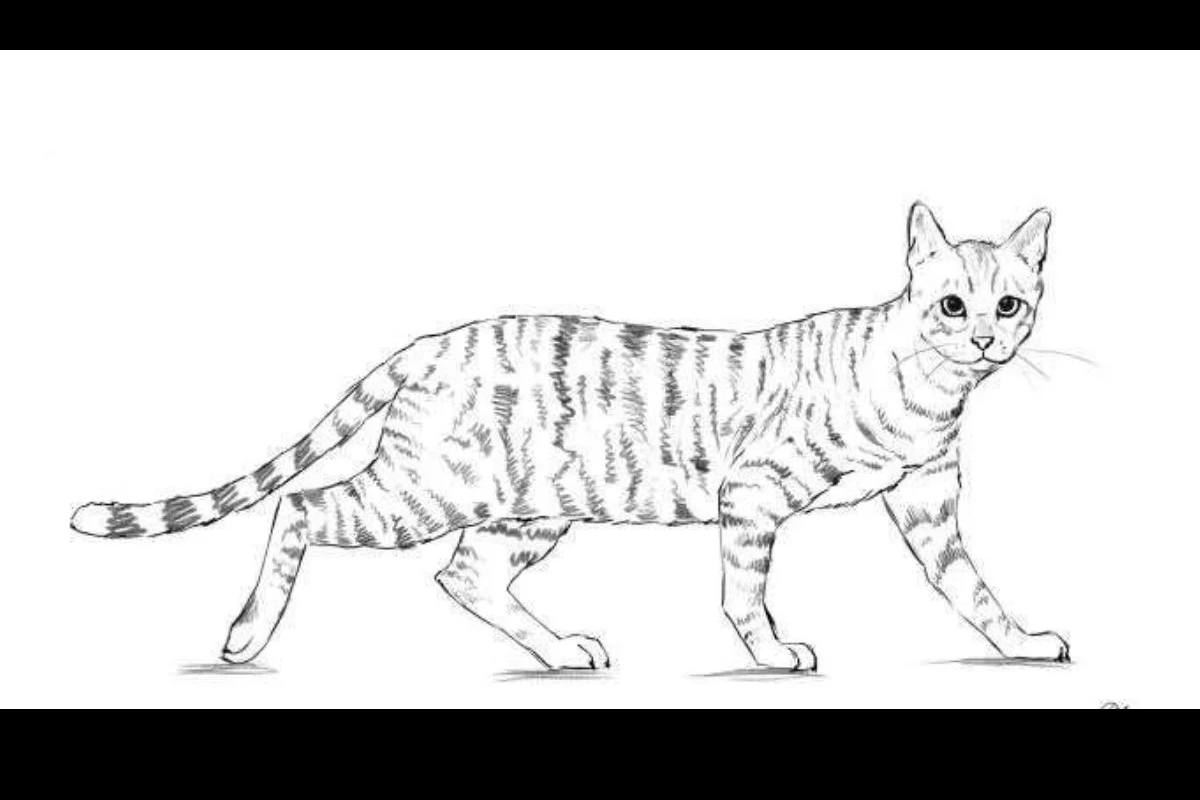Drawing:8mi9vnj1ccs= Cat
Introduction to Drawing:8mi9vnj1ccs= Cat
Drawing a cat can be an intriguing and fulfilling pursuit for artists at any level. As one of the most beloved household pets, the cat embodies various qualities that artists may find appealing. From their graceful movements to their captivating expressions, each feline presents a unique opportunity for exploration and creativity in art.
The techniques for drawing a cat encompass various styles and methods, allowing artists to express their interpretations vividly. Whether one chooses to create a realistic rendering or a whimsical illustration, understanding the anatomy and posture of the cat is vital. Observing how cats move, rest, and interact with their environment can provide insights that enhance the overall artistic depiction. For many, the challenge lies in capturing the delicate balance of fur texture and the subtleties of feline facial features.
Moreover, drawing a cat can be as much about the emotional connection to the subject as it is about technique. Cats are known for their complex personalities, which can shine through in a drawing. By focusing on elements such as the cat’s gaze or the curl of its tail, an artist can evoke a sense of character and liveliness in their work. It emotional element adds layers of depth, making the drawing a technical achievement and a means of storytelling.
Incorporating a variety of mediums, such as pencil, charcoal, or digital tools, can further enhance the artistic process. Each medium allows for distinct expressions and styles, broadening the possibilities for representing a cat. Therefore, embracing the journey of mastering the art of drawing an intricate creature like a cat is a rewarding experience that resonates with artists and cat enthusiasts alike.
Understanding Cat Anatomy for Drawing:8mi9vnj1ccs= Cat
To effectively master the drawing of a cat, understanding its anatomy is essential. A cat’s body structure is uniquely designed for agility and grace, featuring a muscular build for quick movements and flexibility. Starting with the overall silhouette, a cat typically has a long, slender torso characterized by a smooth curve along its back. This curvature helps artists capture the fluid nature of a cat’s movement, whether lounging or pouncing. The body is supported by four slender legs, generally equipped with retractable claws that are also critical to depicting accurately during drawing.
When focusing on the head shape, one must note that a cat’s skull is relatively rounded, with prominent cheeks and a tapering muzzle. The placement of the eyes is particularly important; they are typically located on a horizontal line and often appear large and expressive, contributing significantly to the animal’s character. Artists should pay attention to the slight slant of the eyes, which can convey various emotions and gestures. The ears on a cat are another vital feature; they are triangular and erect, positioned atop the head in a way that allows for a range of movement, enhancing overall expressiveness in drawings.
The tail is an equally important aspect of a cat’s anatomy, often acting as a balance indicator during motion. Depending on the cat’s mood, it can be held high or low, greatly affecting the overall impression of the drawing. Accurately portraying the position and movement of the tail adds to the dynamism of the artwork. By grasping the foundational elements of a cat’s anatomy—its body structure, head shape, and tail positioning—artists can achieve more realistic and dynamic representations. Mastering these anatomical features lays the groundwork for creating captivating drawings that embody this elegant creature’s essence.
Choosing the Right Drawing Tools for Drawing:8mi9vnj1ccs= Cat
When embarking on the journey of drawing 8mi9vnj1ccs=cats, selecting the appropriate tools is crucial for achieving the desired results. The variety of drawing materials available can be overwhelming, but understanding their unique properties can help streamline selection. The primary tools include pencils, papers, erasers, and various accessories, each contributing to the overall quality of the artwork.
First, consider the drawing pencils. Graphite pencils are commonly used, and they come in different hardness levels, ranging from H (hard) to B (soft). For detailed work, a hard pencil (2H or H) is suitable for fine lines, while softer pencils (2B or 4B) can be utilized for shading and expressive strokes. Charcoal pencils are another excellent option for creating rich, bold lines that effectively capture a cat’s texture and form.
Next, selecting the right paper is essential. For drawing cats, medium to heavy-weight paper with a fine texture is recommended, as it holds graphite well and allows for smooth blending. Papers designed specifically for pencil or charcoal work are ideal, as they enhance the overall appearance of the drawing. Sketchbooks with heavier paper can also be portable for practicing various techniques.
Lastly, additional accessories such as blending stumps, sharpeners, and fixatives can enhance the drawing experience. Blending stumps assist in achieving smooth transitions in shading, while fixatives help preserve the completed artwork. By choosing the right tools and materials, artists can effectively capture the elegance and charm inherent in drawing cats.
Techniques for Sketching Cats
Embarking on the journey of drawing 8mi9vnj1ccs=cats can be an enjoyable and rewarding experience. It is essential to grasp some fundamental sketching techniques to render felines’ unique features effectively. First, begin with basic shapes; a cat’s body can be simplified into ovals and rectangles. For instance, use an oval for the head and a larger oval for the body. This method aids in establishing proportion and helps in visualizing the cat’s structure.
Next, focus on proportioning the various parts of the cat. Observing live cats or photographs provides excellent references. A general guideline for a cat’s anatomy involves ensuring that the head is approximately one-third the body’s width. Remember the relationships between different elements, such as the length of the tail to the body, which is typically about the same length as the cat’s. Understanding these relationships will enhance the accuracy of your sketch.
Once the basic shapes and proportions are established, consider creating dynamic poses that exhibit a cat’s characteristic playfulness and grace. Start by lightly sketching the positions of the legs and overall stance, then gradually refine the details, focusing on facial expressions and fur texture. Instead of drawing a stationary figure, capturing a moment of action can bring your artwork to life.
However, as you move through the sketching process, it is crucial to avoid common mistakes. Many beginners over-complicate their sketches too early, forgetting the importance of starting simple. Staying loose during initial sketches will facilitate adjustments as you observe the feline’s form more closely. Pay attention to symmetry, balance, and the relationships among the cat’s features to create a realistic portrayal of this beloved animal.
Adding Details and Textures in Drawing:8mi9vnj1ccs= Cat
When it comes to drawing a cat, the incorporation of details and textures plays a significant role in achieving realism. One of the primary aspects is the depiction of fur, which can vary greatly depending on the breed and individual characteristics of the cat. To render this texture convincingly, observe real cats or reference photographs. Notice how the fur lays, and the light reflects off of it. Using short, quick strokes can emulate the look of fur effectively. For longer-haired cats, longer strokes should be applied, allowing for variations in direction to signify wave and flow.
Patterns on a cat’s coat, such as stripes or spots, can add an extra layer of interest to your drawing. Begin by lightly sketching these patterns before layering your shading and detailing. Please pay attention to how these markings interact with the overall shape of the cat and allow them to form a natural extension of the body’s contours. Utilizing an eraser can be helpful in refining areas where the pattern becomes less distinct or where highlights catch the fur’s surface.
Facial expressions are another crucial element when drawing a cat. Capturing the essence of a cat’s personality through its gaze can be achieved by carefully detailing the eyes, whiskers, and mouth. For the eyes, focus on the shape and the pupils, as cats’ eyes can convey various emotions—experiment with shading around the eyes to create depth and subtly highlight areas to suggest a gleaming effect. The alignment of whiskers should be accurately portrayed; they are a prominent feature that often indicates the cat’s mood. Finally, practice soft shading techniques using blending tools or even fingers to ensure smooth transitions between light and dark areas, enhancing the overall appeal and authenticity of your drawing. By meticulously attending to these details, your artwork will embody a lifelike quality that resonates with viewers.
Coloring Techniques for Drawing:8mi9vnj1ccs= Cat
When it comes to adding color to your cat drawing, the choice of medium can meaningfully influence the final appearance of your artwork. Several coloring techniques can be employed, each imparting a unique aesthetic and texture to your feline masterpiece.
Colored pencils are popular among artists for their versatility and ease of use. They allow for detailed layering, enabling you to achieve a range of shades and depth in the cat’s fur. Start with a light hand, building up the color gradually. This method helps create a soft transition between colors, mimicking the natural gradient of the cat’s coat. For instance, mixing browns, blacks, or even grays can bring a realistic quality to your drawing.
Markers also offer an exciting option for coloring cat drawings. Alcohol-based markers are often favored due to their vibrant pigmentation and blending capabilities. They can be used to cover large areas quickly while still maintaining good color saturation. Since markers can sometimes bleed, working on a smooth surface and layer colors with caution is advisable to avoid overwhelming your drawing.
In today’s digital age, digital painting has become a preferred method for many artists. It provides the advantage of using various brushes and tools that can replicate natural mediums while allowing for easy corrections. Digital color palettes can be meticulously crafted to match the unique aspects of the cat’s features, such as eye color and fur patterns.
Understanding color theory basics is essential when selecting your palette. Complementary colors can make features pop, while analogous colors can create harmony within the artwork. Please pay attention to the cat’s natural colors and characteristics to choose a fitting palette to enhance its depiction in your drawing.
Creating Unique Expressions and Poses in Drawing:8mi9vnj1ccs= Cat
Capturing the essence of a cat in drawing:8mi9vnj1ccs= a cat involves translating their diverse emotions and physical actions onto paper. Cats are inherently expressive creatures, showcasing a multitude of feelings from playfulness to relaxation. To successfully depict these emotions, artists should observe how these animals communicate non-verbally, using their posture, facial expressions, and movements.
When drawing playful cats, it is essential to grasp their agile nature. Start by studying how they pounce, stretch, or swat at toys. These actions can be illustrated by employing dynamic lines and a sense of motion. Consider using curved strokes to represent a cat’s sinuous body as it leaps or crouches. Capturing the intent in their eyes, with a focus on wide openings or narrowed slits, adds depth to the joyful energy often displayed during play.
Contrasting playfulness, a relaxed cat embodies tranquility and satisfaction. Observe their loafed positions or languid stretches to portray relaxation in your drawing:8mi9vnj1ccs= cat. Depicting a content cat involves gentle, flowing lines emphasizing their peaceful state. Soft features, such as drooping eyelids or a subtle smile, can be effectively rendered to encapsulate this ease.
It is also beneficial to experiment with varying poses that may reflect behavior common in cats. For instance, a cat grooming or curling up in a ball reveals a sense of intimacy and comfort. Artists should challenge themselves to capture these authentic moments while focusing on unique angles and perspectives. Doing so fosters individuality in one’s work, moving beyond mere imitation to generate original artistic expressions.
By delving deep into the behavioral traits of felines, artists can cultivate a greater understanding of how to convey emotion and action, making their drawing:8mi9vnj1ccs= cat artwork more vibrant and relatable.
Incorporating Backgrounds in Drawing:8mi9vnj1ccs= Cat
In art, the background plays a pivotal role in enhancing the central subject—such as a cat—by providing context and depth to the drawing. It is particularly true in the drawing of cats, where the background must complement the feline form without overshadowing it. An effectively designed background can direct the viewer’s attention to the cat, creating a more engaging and impactful composition.
When considering backgrounds for cat drawings, simplicity often proves most effective. A minimalistic approach allows the cat’s details to remain the focal point while providing a sense of setting. For instance, a soft gradient that mimics a sunset can elicit a mood of tranquility, making it an excellent choice to set off a resting or sleeping cat. Similarly, a gentle field of grass or a subtle wooden floor can provide a grounded feeling, making the cat appear more at home within the artwork.
Additionally, hints of texture can add allure to the drawing. Light brush strokes that suggest foliage or abstract shapes can provide richness without detracting attention from the main subject. Colors in the background should ideally harmonize with the predominant hues of the cat’s fur, ensuring that the two elements work cohesively. Using analogous colors—those adjacent to the primary colors in the cat’s palette—can effectively create a gentle transition between the foreground and background.
Ultimately, the choice of background is about balance and harmony. The aim is to elevate the cat drawing, ensuring it captivates the observer’s attention. Integrating thoughtful backgrounds can transform a simple cat depiction into an evocative artwork, enhancing its emotional resonance while retaining the cat’s character at the forefront of the viewer’s experience.
Conclusion
This guide explored various techniques and approaches to enhance your skills in drawing cats. Whether you are a beginner or an experienced artist, mastering the intricacies of drawing felines involves understanding their anatomy, exploring different styles, and practicing regularly. We highlighted the importance of observational skills, noting how studying real-life cats can greatly inform your artistic interpretations. Additionally, we delved into essential tools and materials that facilitate the drawing process, from sketching pencils to digital drawing tablets.


